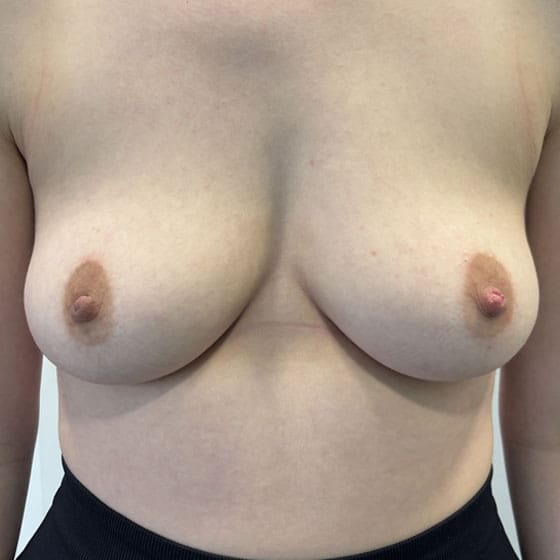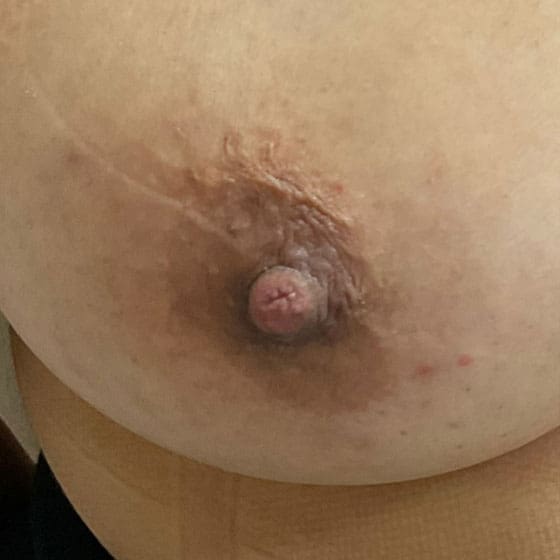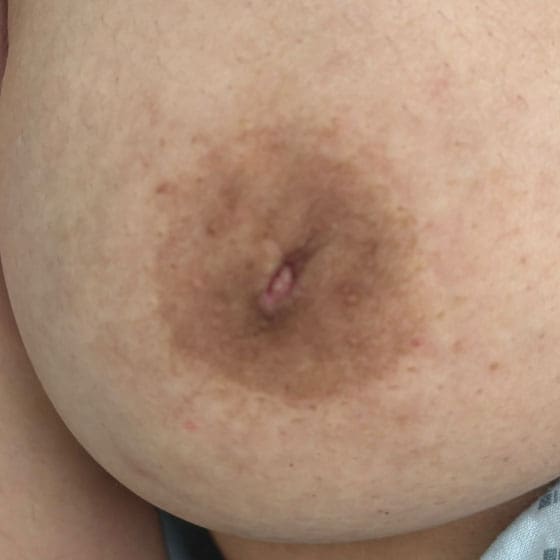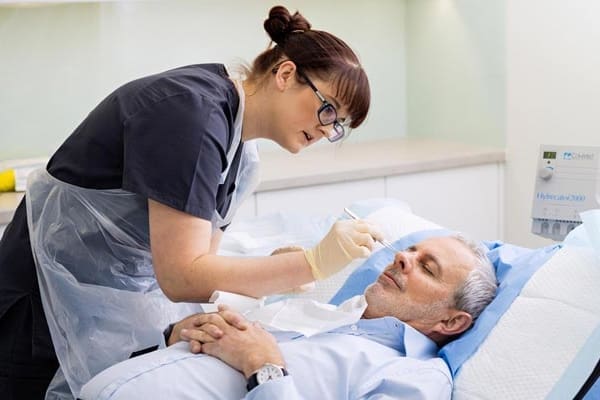Inverted nipples affect approximately 10-20% of the population and can occur in both women and men. Most people will choose to have their inverted nipples corrected for cosmetic reasons and this relatively straightforward procedure can be transformative.
Plastic Surgery
Inverted Nipple Surgery Cambridge


At A Glance
Price:
From £1750
Expected Results:
Improved nipple projection
Length of Surgery:
45-60 mins
Anaesthesia:
Local
Recovery:
1-2 weeks
What is inverted nipple surgery?
Inverted nipple surgery is a procedure which focuses on enhancing the appearance of the nipples, in particular, correcting nipple inversion.
The Consultation

During a pre-treatment consultation for inverted nipple surgery, Mr Abood conducts a comprehensive assessment. He discusses the patient’s concerns, aesthetic goals along with background information regarding their medical history. Detailed examination of nipple size, shape, and symmetry are performed. During the consultation Mr Abood will ask to take medical photographs which will be stored confidentially in the patient’s medical records and used to help plan the procedure as well as monitoring the impact of it.
During the consultation Mr Abood will discuss the details of the procedure, expected recovery, associated side-effects or risks and anticipated aesthetic outcome. If correction of inverted nipples is part of a broader breast enhancement or reconstruction, these aspects will also be discussed.
The Procedure

Surgically correcting inverted nipples typically involves a procedure called nipple correction surgery or inverted nipple correction. It is an out-patient based procedure that is frequently carried out in the bespoke procedure rooms at The Day Clinic. Here are the general steps involved in the surgical correction of inverted nipples.
1. Anesthesia: The procedure is usually performed under local anaesthesia. During local anaesthesia the patient remains fully awake, but the nipples are made numb through an injection of local anaesthetic. Although the injection will sting a little for a few moments, it will enable the procedure to be painless.
2. Incision: A small incision is made at the base of the nipple or around the areola.
3. Release of tethered milk ducts: The surgeon will release any milk ducts or tissue fibres that are causing the nipple to be inverted.
4. Nipple projection: Once the milk ducts are released, the surgeon will use various techniques to create a more projected and natural-looking nipple. This may involve reshaping and repositioning the nipple tissue.
5. Suturing: The incisions are then closed with sutures, which are usually absorbable.
6. Dressing: The surgeon will apply a dressing to protect the incisions and the nipple while it is healing.
Recovery after nipple correction surgery usually takes a few days to a week. It is common to experience some swelling, bruising, and discomfort, which can be managed with simple pain medication and by following post-operative instructions.
Aftercare & Results

Following inverted nipple surgery patients can go home shortly afterwards. The nipple will usually be protected by a supportive or padded dressing for the first week and this will stay in place until the first follow up appointment. Any sutures that are used during the procedure are usually dissolvable and therefore do not need to be removed.
It is common for patients to experience temporary swelling, bruising and alterations in sensation following any nipple surgery. These side-effects will generally subside over the following days and weeks. The nipple is a delicate structure so Mr Abood will advise about when and what type of activity patients can start to re-introduce following surgery, as they begin to return to their usual activities.
Results following nipple surgery become increasingly apparent as swelling subsides, with the outcome becoming evident after several weeks. Most patients are extremely happy with the results of their inverted nipple correction and pleasantly surprised at the simplicity of the procedure and recovery.
What our clients think
Thanks Dr Abood!
Plenty of parking and easy to find.
The Day Clinic is very easy to find and plenty of parking available.
I would recommend Dr Abood to anyone wanting a procedure.
where I had a Lipoma and a small cyst removed from my face. I shall be returning next week to have my stitches removed.
The Day Clinic is also very accessible being on the outskirts of Cambridge.
Although I'm still to see the final healed result I would thoroughly recommend the day Clinic for small ops like mine.
Potential Risks
All surgery, no matter how minor, carries some element of risk and potential side effects however every effort is taken to make sure your surgery is as safe as possible. This process starts at the point of patient selection. In other words, deciding whether you are suitable for surgery, and continues throughout your surgical journey and aftercare. Mr Abood is a highly trained and experienced consultant plastic surgeon and will discuss the potential risks involved and anticipated outcomes before you embark upon surgery.
Here are some potential risks associated with inverted nipple surgery:
1. Infection: There is a risk of developing an infection at the surgical site. This can usually be managed with antibiotics, but in rare cases, it may require further treatment or revision surgery.
2. Bleeding: There is a possibility of minor bleeding during or after the surgery. Minor bleeding is common and will stop spontaneously and very rarely would any other intervention be require.
3. Scarring: Inverted nipple correction surgery involves making at least one small incision, which can result in a scar. The scar is generally inconspicuous and will often be barely visible. It’s important to follow post-operative care instructions to promote proper healing and minimize scarring.
4. Changes in nipple sensation: There is a risk of temporary or permanent changes in nipple sensation after surgery. Nipple sensitivity may increase, decrease, or be lost altogether. The extent of these changes varies from person to person.
5. Nipple asymmetry: In some cases, there may be a slight difference in the position or appearance of the corrected nipples. Perfect symmetry is never guaranteed, and all nipples and breasts will have some degree of asymmetry.
6. Difficulty breastfeeding: Inverted nipple surgery may affect the ability to breastfeed. If you are planning to have children in the future and wish to breastfeed, it is important to discuss this with your surgeon beforehand.
All of the plastic surgeons at The Day Clinic are highly qualified and experienced and will aim to minimize these risks and provide you with the best possible outcome. They will evaluate your individual case and discuss the potential risks and benefits specific to you.
Related FAQs
What is the recovery process after inverted nipple surgery?
After the surgery you may experience some swelling, bruising and mild discomfort in the area. In the first week following the procedure you will wear a protective dressing to help support the healing process. Most people resume normal activities within a few days but we advise avoiding strenuous activities or pressure on the nipple for a few weeks. You may be advised not to wear padded bras or tight fitting tops for 10-14 days after surgery. We would also recommend not sleeping on your front for the first two weeks following this procedure as this can compress the nipple .
Will the results of inverted nipple surgery be permanent?
n most cases the results of this procedure are permanent. The surgery aims to release the tissue that is causing the nipple inversion and to reshape the nipple to create a more outward appearance. Once this procedure has been done the nipple should retain the new shape.
Can I breastfeed following inverted nipple surgery?
The ability to breastfeed after this procedure depends on the specific surgical technique used and your individual anatomy. In some cases, the procedure has no impact on breastfeeding, while in others the surgery can disrupt the flow of milk. If you have yet to complete your family and are concerned about breastfeeding, it’s a good idea to discuss this with your consultant to find out more.
Will I lose sensation after inverted nipple surgery?
Your nipple sensation may change slightly in the short-term following this procedure but once fully healed, nipple sensation should return to normal.
Does inverted nipple surgery hurt?
The procedure will be performed under local anaesthetic to ensure you do not feel any pain during the surgery. After surgery, you may experience some mild discomfort, swelling or bruising in the treated area. This can usually be managed with over-the-counter pain medication along with following post-operative care guidance to minimise any discomfort.
Treatment Videos
As a helpful resource to understanding your treatment at The Day Clinic we have created these informative videos which explain this treatment in detail.
We are still more than happy to answer any questions you have so just get in touch via our contact page.





